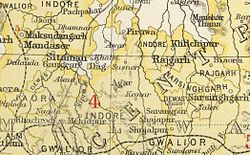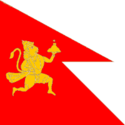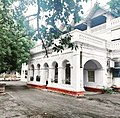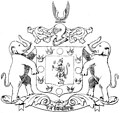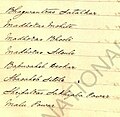History
The original state was founded in 1728 by Jivaji Rao, from the Puar clan of Marathas who together with his older brother (Tukoji) had advanced into Malwa with Peshwa Baji Rao, as part of the Maratha conquest. [2]
The brothers divided the territory among themselves; their descendants ruled as the junior and senior branches of the family. After 1841, each branch ruled his own portion as a separate state, though the lands belonging to each were intimately entangled; in Dewas, the capital town, the two sides of the main street were under different administrations and had different arrangements for water supply and lighting. [3]
The Junior branch had an area of 440 sq mi (1,100 km2) and had a population of 54,904 in 1901. [4] Both Dewas states were in the Malwa Agency of the Central India Agency. After India's independence in 1947, the Maharajas of Dewas acceded to India, and their states were integrated into Madhya Bharat, which became a state of India in 1950. In 1956, Madhya Bharat was merged into Madhya Pradesh state.
Dewas Junior Darbar (Court) was composed of Sardars, Mankaris, Istamuradars, Thakurs and Jagirdars. [5] [6]
An old photograph of Goddess Chamunda Mata's Temple on
Dewas Tekri (Hill).
The Old Palace (Rajwada) of Dewas Junior.
The Durga Bagh Palace, Dewas Junior State.
Shree Lakshmi Narayan Bhawan Club, Dewas Junior State.
Shree Narayan Tower, Dewas Junior State. The Clock Tower is named after HH Raja Srimant Narayanrao (Dada Sahib) Puar of Dewas Junior State.
The Gate at Shree Malhar, The Residence of His Holiness Shri Shilnath Maharaj.
The Law Courts, Dewas Junior State.
Dewas Collectorate Building (originally known as Lakshmi Niwas Palace of Dewas Junior). This was illegally demolished by the local administration in March 2023, despite an ongoing case and strong opposition by the citizens of Dewas.
Dewas Junior Coat of Arms
1890 List of Dewas Junior Sardars & Mankaris Page 01
1890 List of Dewas Junior Sardars & Mankaris Page 02
1890 List of Dewas Junior Sardars & Mankaris Page 03
1890 List of Dewas Junior Sardars & Mankaris Page 04
This page is based on this
Wikipedia article Text is available under the
CC BY-SA 4.0 license; additional terms may apply.
Images, videos and audio are available under their respective licenses.
